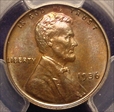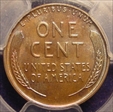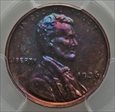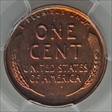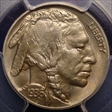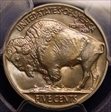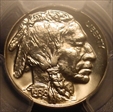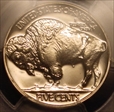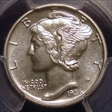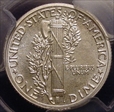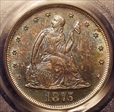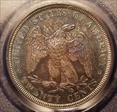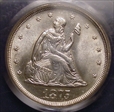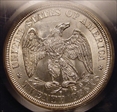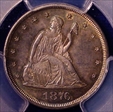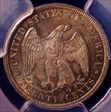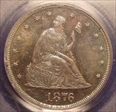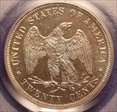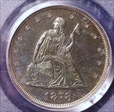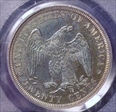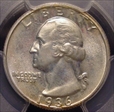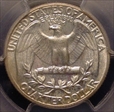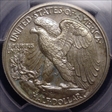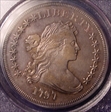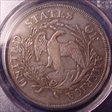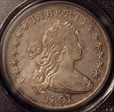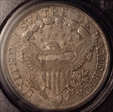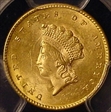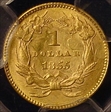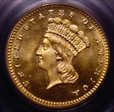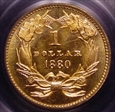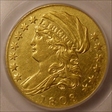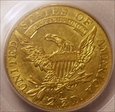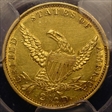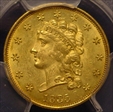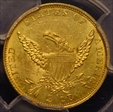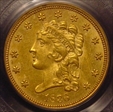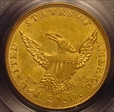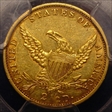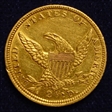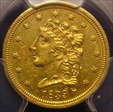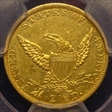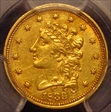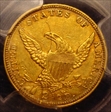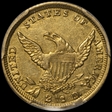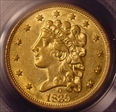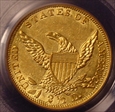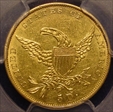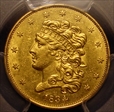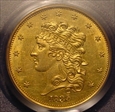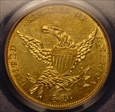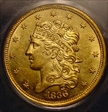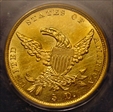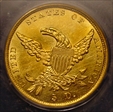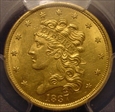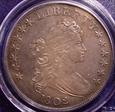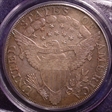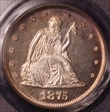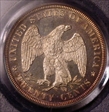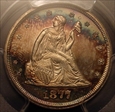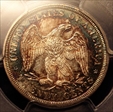[email protected] 的钱币相册
I am not a big fan of red copper. In view of that my two 1936 Proof cents are pedestrian examples. I find this attractive for what it is. I would rather have toning than spots.
I am not a big fan of red copper. In view of that my two 1936 Proof cents are pedestrian examples. I find this attractive for what it is. I would rather have toning than spots.
Since I'm not a fan of red copper, this coin is a bit of a hole filler. It looks better in person and has a lot of red on the reverse which not visible in my photo. I found this coin to be very hard to photograph.
Since I'm not a fan of red copper, this coin is a bit of a hole filler. It looks better in person and has a lot of red on the reverse which not visible in my photo. I found this coin to be very hard to photograph.
I believe that this is the most attractive example of the Buffalo Nickel design that is in my collection. This piece is an example of how a Matte or satin finish can showcase the design. Unfortunately not all of the previous Matte Proof Nickels came out this nice.
I believe that this is the most attractive example of the Buffalo Nickel design that is in my collection. This piece is an example of how a Matte or satin finish can showcase the design. Unfortunately not all of the previous Matte Proof Nickels came out this nice.
The 1936 and '37 Proof Buffalo Nickels were so bright that it is almost out shines the design. The is beautiful in its own right, but I prefer the satin finish piece, which is actually less expensive.
The 1936 and '37 Proof Buffalo Nickels were so bright that it is almost out shines the design. The is beautiful in its own right, but I prefer the satin finish piece, which is actually less expensive.
This piece represents the debut of the Mercury Dime in the Proof format. It is a decent example that shows some of the field clutter from minor flacks of chromium from the dies. This was an on-going problem with the 1936 to '42 Proof coin production process.
This piece represents the debut of the Mercury Dime in the Proof format. It is a decent example that shows some of the field clutter from minor flacks of chromium from the dies. This was an on-going problem with the 1936 to '42 Proof coin production process.
I have never been a fan of the Washington Quarter design. I find the obverse to be bland and uninspiring and the reverse to be cramped. Perhaps the 1936 Proof coin buyers agreed with me. The mint sold only 3,837, 1936 Proof quarters which makes it the lowest mintage coin in the set.
I have never been a fan of the Washington Quarter design. I find the obverse to be bland and uninspiring and the reverse to be cramped. Perhaps the 1936 Proof coin buyers agreed with me. The mint sold only 3,837, 1936 Proof quarters which makes it the lowest mintage coin in the set.
This coin marked the introduction of the beautiful Walking Liberty Half Dollar design in the Proof format. It was also the debut for the Mercury Dime and Washington Quarter.
This coin marked the introduction of the beautiful Walking Liberty Half Dollar design in the Proof format. It was also the debut for the Mercury Dime and Washington Quarter.
This coin marked the introduction of the beautiful Walking Liberty Half Dollar design in the Proof format. It was also the debut for the Mercury Dime and Washington Quarter.
The Philadelphia Mint began to strike these coins officially on August 1, 1834. These pieces were authorized by the Coinage Act of 1834 which reset the weight ratio between silver and gold from 15 to 1 to 16 to 1. The result was that U.S. gold coins began to circulate in The United States for the first time in many years. All of the Classic Head gold coinage is very scarce in Mint State. The 1834 quarter eagle is the second most common date in the series after the 1836.
The Philadelphia Mint began to strike these coins officially on August 1, 1834. These pieces were authorized by the Coinage Act of 1834 which reset the weight ratio between silver and gold from 15 to 1 to 16 to 1. The result was that U.S. gold coins began to circulate in The United States for the first time in many years. All of the Classic Head gold coinage is very scarce in Mint State. The 1834 quarter eagle is the second most common date in the series after the 1836.
The Classic head gold coins were President Andrew Jackson's answer to the unstable monetary conditions of his time. He believed that yeoman farmers were better off if they could use small denomination gold coins and avoid paper money. Given the state of banking industry in Jackson's day, that was sound advice. In 1834 Andrew Jackson's right hand man in the Sentate, Thomas Hart Benton, introduced legislation that raised the ratio between silver and gold from 15 to 1 to 16 to 1. This coin and it's $5 counterpart were the result of this legislation. For the first time gold coins saw a fair amount of use in the U.S. economy. As a result of this, these coins are quite scarce in strictly Mint State condition. The coin show above has ultra smooth surfaces with the usual weak center on the obverse due to a die crack that runs from the 6th star, through the center and ends behind the curls in back of Ms. Liberty's neck.
The Classic head gold coins were President Andrew Jackson's answer to the unstable monetary conditions of his time. He believed that yeoman farmers were better off if they could use small denomination gold coins and avoid paper money. Given the state of banking industry in Jackson's day, that was sound advice. In 1834 Andrew Jackson's right hand man in the Sentate, Thomas Hart Benton, introduced legislation that raised the ratio between silver and gold from 15 to 1 to 16 to 1. This coin and it's $5 counterpart were the result of this legislation. For the first time gold coins saw a fair amount of use in the U.S. economy. As a result of this, these coins are quite scarce in strictly Mint State condition. The coin show above has ultra smooth surfaces with the usual weak center on the obverse due to a die crack that runs from the 6th star, through the center and ends behind the curls in back of Ms. Liberty's neck.
After a record mintage of almost 548 thousand quarter eagles in 1836, the production dropped off dramatically in 1837 to a little over 45 thousand. Part of the reason for this low mintage was probably the Panic of 1837 which curtailed economic activity. It has been estimated that only about 300 of these coins exist today.
After a record mintage of almost 548 thousand quarter eagles in 1836, the production dropped off dramatically in 1837 to a little over 45 thousand. Part of the reason for this low mintage was probably the Panic of 1837 which curtailed economic activity. It has been estimated that only about 300 of these coins exist today.
The 1838-C quarter eagle and its "big sister" the 1838-C half eagle were the first coins struck at the Charlotte mint. Unlike many of the subsequent issues, these quarter eagles were generally well struck. The hair detail on the obverse is often quite strong, stronger in fact than many of the Philadelphia mint Classic Head quarter eagles. The reverse is not quite is well defined but is usually adequately defined. Many pieces display a depressed area on Ms. Liberty's cheek, which was probably from the adherence of a foreign substance on the die at the time the pieces were struck. Despite a low mintage of 7,880 pieces, the 1838-C quarter eagle is not quite as scarce as that mintage would indicate. Doug Winter has estimated that 150 to 200 examples of the coin have survived in unimpaired collectable states of preservation. Many pieces display marks and wear, however, which makes high grade examples scarce and desirable. Since this was the first Classic Head quarter eagle that was produced at the Charlotte mint and one of only two years in which this design was produced , this coin is a prime collectors' item. The coin pictured above is a choice example of this scarce coin in AU-55 condition. The surfaces are generally smooth with only a small number of marks, and the color is rich and original. This example does not have the mark on Ms. Liberty's cheek which is sometimes seen on this issue of quarter eagles.
The 1838-C quarter eagle and its "big sister" the 1838-C half eagle were the first coins struck at the Charlotte mint. Unlike many of the subsequent issues, these quarter eagles were generally well struck. The hair detail on the obverse is often quite strong, stronger in fact than many of the Philadelphia mint Classic Head quarter eagles. The reverse is not quite is well defined but is usually adequately defined. Many pieces display a depressed area on Ms. Liberty's cheek, which was probably from the adherence of a foreign substance on the die at the time the pieces were struck. Despite a low mintage of 7,880 pieces, the 1838-C quarter eagle is not quite as scarce as that mintage would indicate. Doug Winter has estimated that 150 to 200 examples of the coin have survived in unimpaired collectable states of preservation. Many pieces display marks and wear, however, which makes high grade examples scarce and desirable. Since this was the first Classic Head quarter eagle that was produced at the Charlotte mint and one of only two years in which this design was produced , this coin is a prime collectors' item. The coin pictured above is a choice example of this scarce coin in AU-55 condition. The surfaces are generally smooth with only a small number of marks, and the color is rich and original. This example does not have the mark on Ms. Liberty's cheek which is sometimes seen on this issue of quarter eagles.
The 1839-P quarter eagle is an underrated coin. "Coin Facts" estimates that only 115 examples of this date exits. The PCGS population reports show 11 coins graded in AU-58 and only eight coins graded higher. The top PCGS coin is graded MS-62. NGC has graded two pieces in MS-63. Of course all of us are familiar with the term "grade-flation," and this coin might be an example of it. I was able to trace this coin to a Heritage sale in February 2014. At that time it was in a PCGS AU-55 holder. A check of the serial number showed that there is no longer of a record of this piece in the AU-55 holder on the PCGS files. I'm guessing that this one was sent in for grade reconsideration and won the argument for the higher grade. This coin has attractive, original surfaces with a pleasing golden orange color. The only factor that might keep one from grading this coin AU-58 is the mark in front of Ms. Liberty's nose. Otherwise it has the luster and general look of an AU-58, at least so far as Classic Head quarter eagles are concerned. Overall these coins tend to get a bit of grade push because strictly Mint State examples are decidedly very scarce to rare. Back in the day these coins saw a lot of use, and what few collectors there were tended not to save and preserve them.
The 1839-P quarter eagle is an underrated coin. "Coin Facts" estimates that only 115 examples of this date exits. The PCGS population reports show 11 coins graded in AU-58 and only eight coins graded higher. The top PCGS coin is graded MS-62. NGC has graded two pieces in MS-63. Of course all of us are familiar with the term "grade-flation," and this coin might be an example of it. I was able to trace this coin to a Heritage sale in February 2014. At that time it was in a PCGS AU-55 holder. A check of the serial number showed that there is no longer of a record of this piece in the AU-55 holder on the PCGS files. I'm guessing that this one was sent in for grade reconsideration and won the argument for the higher grade. This coin has attractive, original surfaces with a pleasing golden orange color. The only factor that might keep one from grading this coin AU-58 is the mark in front of Ms. Liberty's nose. Otherwise it has the luster and general look of an AU-58, at least so far as Classic Head quarter eagles are concerned. Overall these coins tend to get a bit of grade push because strictly Mint State examples are decidedly very scarce to rare. Back in the day these coins saw a lot of use, and what few collectors there were tended not to save and preserve them.
Doug Winter describes the 1839-C quarter eagle as one of the more common Charlotte Mint issues, but that characterization is misleading. Although a fair number of these coins exit in Very Fine and Extremely Fine condition, Almost Uncirculated and Mint State examples are quite scarce. During my search for an example of this issue for my collection, I noted several pieces, graded by a service other than PCGS that were called “Mint State.” All of these coins had been cleaned and ruined my opinion. My message to the perspective collector is that these coins are very scarce and hard to find with original surfaces. This coin is the 1839-C Winter variety #2. It has a recut date. The dies that was used to strike this coin were on their last legs. Both sides show extensive die cracks.
Doug Winter describes the 1839-C quarter eagle as one of the more common Charlotte Mint issues, but that characterization is misleading. Although a fair number of these coins exit in Very Fine and Extremely Fine condition, Almost Uncirculated and Mint State examples are quite scarce. During my search for an example of this issue for my collection, I noted several pieces, graded by a service other than PCGS that were called “Mint State.” All of these coins had been cleaned and ruined my opinion. My message to the perspective collector is that these coins are very scarce and hard to find with original surfaces. This coin is the 1839-C Winter variety #2. It has a recut date. The dies that was used to strike this coin were on their last legs. Both sides show extensive die cracks.
Although the Charlotte mint issued both quarter eagles and half eagles during its first year of operations in 1838, the Dahlonega mint didn't issue its first quarter eagles until the beginning of 1839. I have been unable to uncover a reason for this from the five reference books that I have on the subject. I suspect that the Philadelphia Mint, which produced all of the dies for the branch mints, did not send any quarter eagle dies to Dahlonega in 1838. Chief Mint Engraver, Christian Gobrecht, introduced his Liberty Head design to the half eagle in 1839. The was a delay in that introduction which met that the Philadelphia Mint only had Classic Head quarter eagle dies available for the branch mints. Therefore during the first part of the year, the Charlotte, Dahlonega and New Orleans gold coin production was limited quarter eagles only. Once the half eagle dies arrived, the two Charlotte and Dahlonega Mints initiated production of those coins. I have read that the Dahlonega Mint personnel disliked making quarter eagles because they had technical problems with them. Many pieces exhibit die breaks and die clashes which would have resulted in more downtime for repairs and adjustments. Also those who deposited gold for coinage at the Dahlonega Mint preferred half eagles to quarter eagles. Therefore the quarter eagle mintages at the Dahlonega Mint were small through the series. The 1839-D quarter eagle is a scarce and highly popular one year type coin. This was the only year that the Dahlonega mint issued the Classic Head quarter eagle design. Although the mintage was 13,675, specialist dealer, Doug Winter, has estimated that only 200 to 250 examples survive today. Among those survivors the most often seen examples grade in the VF and EF categories. This piece, which just barely meets the Mint State grade with an MS-60 is among the dozen or so pieces that qualify for the Uncirculated grade. The finest known examples of this coin are in MS-64.
Although the Charlotte mint issued both quarter eagles and half eagles during its first year of operations in 1838, the Dahlonega mint didn't issue its first quarter eagles until the beginning of 1839. I have been unable to uncover a reason for this from the five reference books that I have on the subject. I suspect that the Philadelphia Mint, which produced all of the dies for the branch mints, did not send any quarter eagle dies to Dahlonega in 1838. Chief Mint Engraver, Christian Gobrecht, introduced his Liberty Head design to the half eagle in 1839. The was a delay in that introduction which met that the Philadelphia Mint only had Classic Head quarter eagle dies available for the branch mints. Therefore during the first part of the year, the Charlotte, Dahlonega and New Orleans gold coin production was limited quarter eagles only. Once the half eagle dies arrived, the two Charlotte and Dahlonega Mints initiated production of those coins. I have read that the Dahlonega Mint personnel disliked making quarter eagles because they had technical problems with them. Many pieces exhibit die breaks and die clashes which would have resulted in more downtime for repairs and adjustments. Also those who deposited gold for coinage at the Dahlonega Mint preferred half eagles to quarter eagles. Therefore the quarter eagle mintages at the Dahlonega Mint were small through the series. The 1839-D quarter eagle is a scarce and highly popular one year type coin. This was the only year that the Dahlonega mint issued the Classic Head quarter eagle design. Although the mintage was 13,675, specialist dealer, Doug Winter, has estimated that only 200 to 250 examples survive today. Among those survivors the most often seen examples grade in the VF and EF categories. This piece, which just barely meets the Mint State grade with an MS-60 is among the dozen or so pieces that qualify for the Uncirculated grade. The finest known examples of this coin are in MS-64.
The 1839-O is a historically important issue. This was the first gold coin to be issued by the New Orleans Mint, and it was the only Classic Head $2.50 the O-Mint produced. It is also the only New Orleans mint quarter eagle that has the mint mark on the obverse. Although this coin has a slightly lower mintage than the 1839-C quarter eagle (17,781 vs. 18,140) it is more common because a larger than normal number of pieces were saved as the first of their kind. The coin pictured above is a very sharp example of this historic coin with a great deal of mint luster. It is the Winter variety #2 ("9" in the date well away from the curl and even with the "3" / the "3" shows recutting on the inside curl / the berry on the reverse is detached from stem / arrow heads are malformed) The dies are also rotated 180 degrees to the "medal turn," which has been noted for this variety. It is believed that this is the scarcer of the two varieties.
The 1839-O is a historically important issue. This was the first gold coin to be issued by the New Orleans Mint, and it was the only Classic Head $2.50 the O-Mint produced. It is also the only New Orleans mint quarter eagle that has the mint mark on the obverse. Although this coin has a slightly lower mintage than the 1839-C quarter eagle (17,781 vs. 18,140) it is more common because a larger than normal number of pieces were saved as the first of their kind. The coin pictured above is a very sharp example of this historic coin with a great deal of mint luster. It is the Winter variety #2 ("9" in the date well away from the curl and even with the "3" / the "3" shows recutting on the inside curl / the berry on the reverse is detached from stem / arrow heads are malformed) The dies are also rotated 180 degrees to the "medal turn," which has been noted for this variety. It is believed that this is the scarcer of the two varieties.
The 1836, "Block 8," variety of the Classic Quarter Eagle is about four times as scarce as the "Script 8" variety, but it is not a very scarce coin. The mintage and the survival rate for the 1836 quarter eagles were high, which makes this coin one of the easier pieces to find in the series. The coin show above is a very pleasing example for the AU-55 grade. The surfaces are original with minimal marks, and the eye appeal is good for the grade.
The 1836, "Block 8," variety of the Classic Quarter Eagle is about four times as scarce as the "Script 8" variety, but it is not a very scarce coin. The mintage and the survival rate for the 1836 quarter eagles were high, which makes this coin one of the easier pieces to find in the series. The coin show above is a very pleasing example for the AU-55 grade. The surfaces are original with minimal marks, and the eye appeal is good for the grade.




















